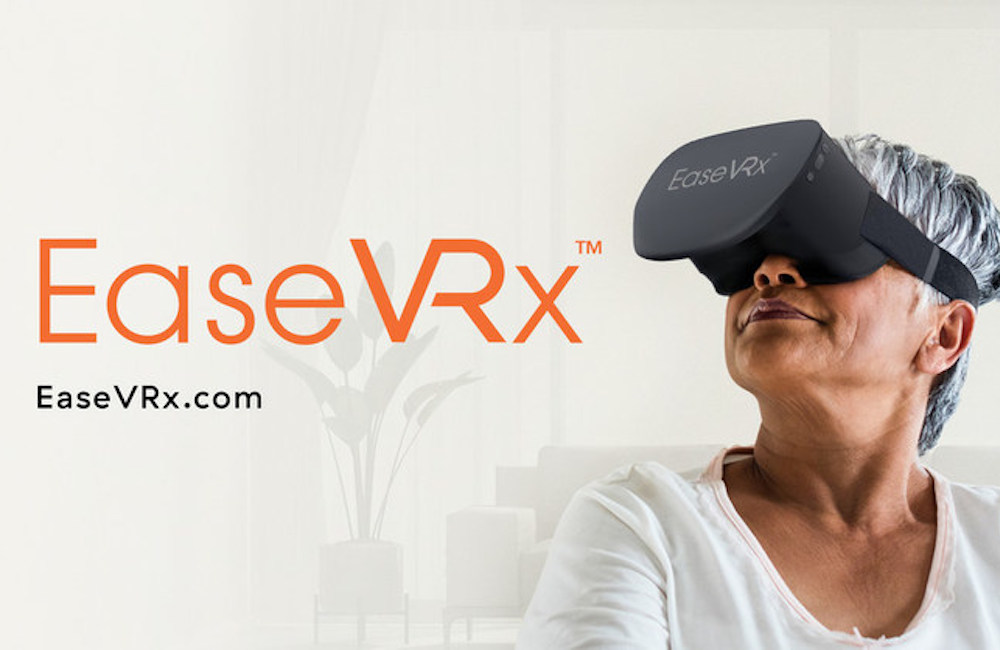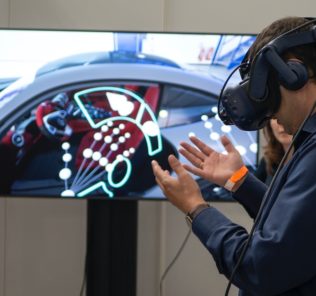VR System for Chronic Pain Reduction Authorized by FDA
As virtual reality technology expands, VR systems have continuously been deployed across healthcare simulation to train learners on how to treat various medical conditions. Today, these VR systems have become so advanced that they are even able to be used directly by patients as part of their cognitive behavioral therapy. An example of this type of prescription-use immersive virtual reality, the EaseVRx system (manufactured by AppliedVR) can be used to help with pain reduction in patients 18 years of age and older with diagnosed chronic lower back pain. Providing the system’s success, the U.S. Food and Drug Administration authorized the marketing of EaseVRx in late-2021.
To reduce the burden of chronic pain and increase function through an emotional, EaseVRx employs the principles of CBT and other behavioral therapy techniques. The prescription device consists of a VR headset and a controller, along with a “Breathing Amplifier” attached to the headset that directs a patient’s breath toward the headset’s microphone for use in deep breathing exercises.
Designed for at-home self-use, the device’s VR program uses established principles of behavioral therapy intended to address the physiological symptoms of pain and aid in pain relief through a skills-based treatment program. These principles include deep relaxation, attention-shifting, interoceptive awareness–the ability to identify, access, understand and respond appropriately to the patterns of internal signals—and perspective-taking, distraction, immersive enjoyment, self-compassion, healthy movement, acceptance, visualization, knowledge of pain and rehabilitation.
Sponsored Content:
Intended to be used as part of a daily eight-week treatment program, the EaseVRx treatment program consists of 56 VR sessions that are 2-16 minutes in length. Each session incorporates elements of the aforementioned principles to provide the user with skills to achieve relief and reduction in the interference of pain in daily activities.
“Millions of adults in the United States are living with chronic lower back pain that can affect multiple aspects of their daily life,” said Christopher M. Loftus, M.D., acting director of the Office of Neurological and Physical Medicine Devices in the FDA’s Center for Devices and Radiological Health, in a press release. “Pain reduction is a crucial component of living with chronic lower back pain. Today’s authorization offers a treatment option for pain reduction that does not include opioid pain medications when used alongside other treatment methods for chronic lower back pain.”
FDA VR System Evaluation
As reported in an agency press release, the FDA evaluated the safety and effectiveness of EaseVRx in a randomized, double-blinded clinical study of 179 participants with chronic lower back pain who were assigned to one of two eight-week VR programs: the EaseVRx immersive 3-D program or a control 2-D program that did not utilize skills-based CBT methods of treatment. After enrollment in the trial, participants were followed for a period of 8.5 months total, including a two-week baseline assessment period, an eight-week VR program, a post-treatment assessment, and follow-up at one, two, three, and six months after completion of the program.
Sponsored Content:
At the end of treatment, 66% of EaseVRx participants reported a greater than 30% reduction in pain, compared to 41% of control participants who reported a greater than 30% reduction in pain. Furthermore, 46% of EaseVRx participants reported a greater than 50% reduction in pain compared to 26% of control participants. At one-month follow-up, all participants in the EaseVRx group continued to report a 30% reduction in pain and at the two- and three-month follow-up marks, the 30% reduction in pain remained for all outcomes with the exception of pain intensity. In contrast, the control group reported a reduction in pain below 30% at one-, two-, and three-month follow-up for all outcomes.
To evaluate the effectiveness of EaseVRx, at the end of the eight-week program, participants were asked to rate the following outcomes on a 10-point scale, with 10 being the greatest value: pain intensity, pain interference on activity, pain interference on mood, pain interference on sleep and pain interference on stress. On average, participants experienced a decrease in pain intensity of 1.31 points over the eight weeks of treatment. Participants also reported a decrease in pain interference for all measured outcomes that ranged from .95 points to 1.27 points down from their respective scores at the start of treatment.
Notably, no serious adverse events were observed or reported during the study. However, approximately 20.8% of participants reported discomfort with the headset and 9.7% reported motion sickness and nausea.
EaseVRx was granted Breakthrough Device designation. To qualify for such designation, a device must be intended to treat or diagnose a life-threatening or irreversibly debilitating disease or condition and meet one of the following criteria: the device must represent a breakthrough technology; there must be no approved or cleared alternatives; the device must offer significant advantages over existing approved or cleared alternatives, or the availability of the device is in the best interest of patients.
According to the FDA, the agency reviewed EaseVRx through the De Novo premarket review pathway, a regulatory pathway for low-to moderate-risk devices of a new type. Along with this authorization, the FDA is working to establish special controls for devices of this type. This would include requirements related to labeling and performance testing. When met, the special controls, along with general controls, should provide reasonable assurance of safety and effectiveness for devices of this type.
Further, this action creates a new regulatory classification, which means that subsequent devices of the same type with the same intended use may go through the FDA’s 510(k) premarket process, whereby devices can obtain marketing authorization by demonstrating substantial equivalence to a predicate device.
More About AppliedVR
AppliedVR is pioneering evidence-based, immersive VRx—a new category of prescription digital therapeutics—including its product EaseVRx, the first virtual reality-based treatment for pain to receive FDA approval as a Class II medical device. Backed by an unparalleled body of evidence, AppliedVR’s mission is to solve pain through immersive therapeutics with the ultimate goal of a virtual reality pharmacy in every home. By developing the infrastructure and partnerships necessary to transform the pain treatment paradigm, AppliedVR empowers patients to live life—beyond chronic pain.
Learn More About EaseVRx
Lance Baily, BA, EMT-B, is the Founder & CEO of HealthySimulation.com, which he started while serving as the Director of the Nevada System of Higher Education’s Clinical Simulation Center of Las Vegas back in 2010. Lance is also the Founder and acting Advisor to the Board of SimGHOSTS.org, the world’s only non-profit organization dedicated to supporting professionals operating healthcare simulation technologies. His co-edited Book: “Comprehensive Healthcare Simulation: Operations, Technology, and Innovative Practice” is cited as a key source for professional certification in the industry. Lance’s background also includes serving as a Simulation Technology Specialist for the LA Community College District, EMS fire fighting, Hollywood movie production, rescue diving, and global travel. He and his wife Abigail Baily, PhD live in Las Vegas, Nevada with their two amazing daughters.
Sponsored Content:



















